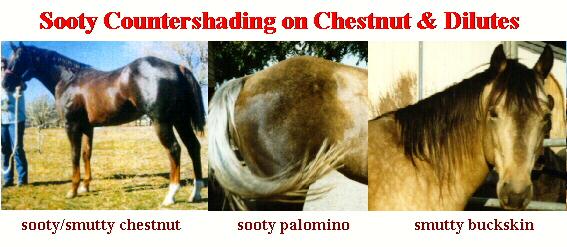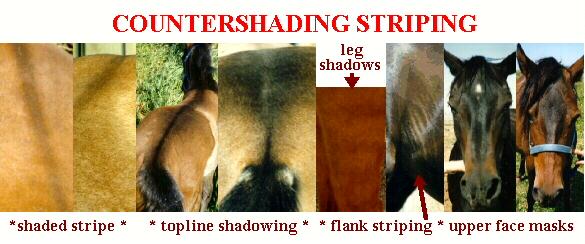

By J. Sharon Batteate
An ancient camouflage technique is countershading. The animal is colored darker along the topline, and paler below, in order to counteract shadows caused by natural overhead light (which lights the top but causes shadows on the underside making the animal look three dimensional). In horses, the darker topline seen on mahogany bays and in the "seal brown" patten, and the colored back and sides, but almost white belly of the "blond sorrel" pattern, are examples of countershading. There have been no studies that I know of, to determine if one or several different genes may be involved in producing these different countershading patterns. "Mealy" (also called Pangare') may produce the blond sorrel, mealy muzzled bay and seal brown countershading patterns. "Sooty" (also called Smutty) may produce the sooty chestnut and palomino, smutty buckskin and dun, and mahogany bay and brown, countershading patterns.




A number of horses with the sooty / smutty type of countershading pattern will also exhibit a form of striping. Some countershaded horses are so dark along the topline, that any sign of striping would be difficult to see. However, in some lighter seal browns, mahogany bays, smutty buckskins, etc. a form of striping along the topline can be seen that is different from Dun Factor striping. Sometimes the stripe is almost as distinct as a dun factor type stripe, but usually the stripe is more of a shaded stripe, sometimes only a partial stripe, and is usually not associated with leg barring. I have seen some cases of countershading striping that also have a faint leg shadowing that is best seen if shaded from direct sunlight, and is thus usually missed, and is very difficult to photograph. It is not the same as the barring seen on the legs of dun factor horses.
Countershading striping does not have to be accompanied by a dilution as the dun factor type usually is. Sometimes the flank areas and neck areas show faint striping that can be seasonal. The dapple pattern may also break the countershaded areas up into streaked as well as splotched patterns. If foals are born red bay with this type of striping down their back, they usually mature mahogany bay or dark bay. Some retain the countershading stripe, but most seem to loose it as they mature, in contrast to the dun factor type of striping which is permanent. Foals born a smokey pale gray color with countershading striping, will usually mature brown or black. They are often mistakenly registered as grulla. Foals born sorrel with countershading striping down their back, will usually mature a darker shade of chestnut. Click here to see countershading foal coat colors.
Return to Yipes! Stripes! index